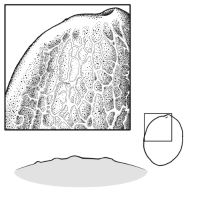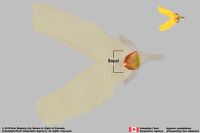Content is from Kirkbride et al. 2006Kirkbride et al. 2006:
Kirkbride JH, Jr, Gunn CR, and Dallwitz MJ. 2006. Family guide for fruits and seeds, vers. 1.0. Accessed September 2020-January 2022. URL: https://nt.ars-grin.gov/seedsfruits/keys/frsdfam/index.cfm ., without modification.
Updates are forthcoming.
Fruits: Pistil(s) simple; 1 to 2–5; 1–3-pistillate. Fruit anthocarpanthocarp:
simple or compound and including some tissue of non-ovarian origin (accessory tissue) , or pericarpium; simple; urticle (Spjut Fig. 53C-D but this appears to be incorrectly scored because the fruit is woodywoody:
, or pericarpium; simple; urticle (Spjut Fig. 53C-D but this appears to be incorrectly scored because the fruit is woodywoody:
texture—consisting mainly of indurate lignified tissues, characteristic of or resembling wood
or a nutnut:
a fairly large, indehiscent, dry fruit with a thick and bony wall surrounding a single seed, derived from a single, simple or compound ovary with an accrescentaccrescent:
with an accrescentaccrescent:
growing continuously
calyx); multiplemultiple:
fruit formed from several flowers clustered in one mass
, or simple; diclesetum (not Spjut: best answer under the circumstances); without persistent central column; within accessory organ(s); within calyxcalyx:
the outer whorl of the perianth; all the sepals of a flower , or sepals; 1-seeded; with 1–3-carpellate (rarely); with carpels separate (more or less); without sterilesterile:
, or sepals; 1-seeded; with 1–3-carpellate (rarely); with carpels separate (more or less); without sterilesterile:
lacking male and/or female reproductive parts; also, not producing fruit or seed
 carpels; apexapex:
carpels; apexapex:
the point farthest from the point of attachment, or the "tip" of an organ beaked; apexapex:
beaked; apexapex:
the point farthest from the point of attachment, or the "tip" of an organ short beaked; indehiscentindehiscent:
short beaked; indehiscentindehiscent:
not opening on its own, as in a fruit
 . Epicarpepicarp:
. Epicarpepicarp:
outer layer of fruit wall or pericarp, if divided into layers; note here used synonymously with exocarp durable; without armature; without wing(s); without apicalapical:
durable; without armature; without wing(s); without apicalapical:
at or pertaining to the end of the seed or fruit distal from its point of attachment (i.e., base)
respiratory hole. Endocarpendocarp:
the inner layer of the pericarp, if divided into layers present; not separating from exocarpexocarp:
present; not separating from exocarpexocarp:
outer layer of fruit wall or pericarp, if divided into layers; note here used synonymously with epicarp ; thin; not splitting into 1-seeded pyrenes; without wing; without operculumoperculum:
; thin; not splitting into 1-seeded pyrenes; without wing; without operculumoperculum:
a dehiscent cap (or lid) of a seed or fruit that opens during germination or dehiscence ; without secretory cavities; without mechanism for seedling escape; without longitudinallongitudinal:
; without secretory cavities; without mechanism for seedling escape; without longitudinallongitudinal:
of or relating to length or the lengthwise dimension
ridges. Funiculusfuniculus:
(alt. funicle) stalk connecting the ovule (later seed) to the ovary (later fruit) placenta short; short without seed bearing hookswith hooks:
short; short without seed bearing hookswith hooks:
bristles or spines with curved or backwards pointing tips, or with secondary bristles along their length (retinacula); not persisting in fruit after seed shed.
(retinacula); not persisting in fruit after seed shed.
Seeds: Arilaril:
(broad sense) appendicular structure that wholly or partly envelops a seed and is produced from or a modification of the funicle, raphe, or outer integument; usually fleshy or pulpy, sometimes spongy or tufted-capillate, often brightly colored absent. Seed larger than minute; not bowl shaped; not nutlike; without winglike beakbeak:
absent. Seed larger than minute; not bowl shaped; not nutlike; without winglike beakbeak:
a usually firm, terminal appendage, sometimes tapered ; without caudatecaudate:
; without caudatecaudate:
tapering to a long, tail-like appendage appendage(s); at maturity without food reserves; without canavanine. Sarcotestasarcotesta:
appendage(s); at maturity without food reserves; without canavanine. Sarcotestasarcotesta:
pulpy or fleshy outer layer of the seed coat, simulates aril absent. Testatesta:
absent. Testatesta:
seed coat
 present; without fleshy or leatheryleathery:
present; without fleshy or leatheryleathery:
texture—moderately thick, tough, and very pliable
layer over hard layer; without crease or line separating cotyledons from hypocotyl-radicle; without notch along margin where cotyledons from hypocotyl-radicle tip approach each other; without glands; without bristles; without wings; without collar; without operculumoperculum:
a dehiscent cap (or lid) of a seed or fruit that opens during germination or dehiscence ; colored; monochrome; not becoming mucilaginousmucilaginous:
; colored; monochrome; not becoming mucilaginousmucilaginous:
resembling mucilage; moist and sticky
when wetted; surrounding embryo. Embryo differentiated from food reserve; well developed; 1 per seed; completely filling testatesta:
seed coat
 (no food reserve); at one end of seed not extending into a depression or cup; foliatefoliate:
(no food reserve); at one end of seed not extending into a depression or cup; foliatefoliate:
appearing leaf-like
; with investinginvesting:
(of embryo) embryo is nearly or completely filling seed coat, straight, and axile and centric with spatulate cotyledons and covering the stalk for at least half its length; (of cotyledons) cotyledons spatulate and covering the stalk for at least half its length
cotyledons; straight (very slightly angledangular:
2D shape—having sides that meet at acute or obtuse angles
); without coleorhiza; without simmondsin; without stomata; not green; with 2 or more cotyledons. Cotyledons 2; well developed; 0.9 times length of embryo (at least); flat; smooth; equal in size; not punctatepunctate:
surface relief—dotted with pits or with translucent, sunken glands or with colored dots, similar to pitted dotted. Hypocotyl-radicle vestigial; straight; not thickened.
dotted. Hypocotyl-radicle vestigial; straight; not thickened.
Notes: Cronquist: "Fruit a short-beaked nutnut:
a fairly large, indehiscent, dry fruit with a thick and bony wall surrounding a single seed, derived from a single, simple or compound ovary with associated accresent, somewhat membranousmembranous:
with associated accresent, somewhat membranousmembranous:
texture—extremely thin, pliable, and fairly tough
, prominently veinedveined:
surface relief—lines that intersect in a vein pattern that is flush or slightly raised from the surface sepals". Spjut has urticle based on Cronquist, but Spjut labelled parts in Fig. 53 C-D as "pericarppericarp:
sepals". Spjut has urticle based on Cronquist, but Spjut labelled parts in Fig. 53 C-D as "pericarppericarp:
fruit wall or fruit coat
" and "seed". Airy Shaw & Mabberley have "dry indehiscentindehiscent:
not opening on its own, as in a fruit
 fruit surrounded by membranousmembranous:
fruit surrounded by membranousmembranous:
texture—extremely thin, pliable, and fairly tough
accrescentaccrescent:
growing continuously
calyxcalyx:
the outer whorl of the perianth; all the sepals of a flower ". Goldberg: sepalssepal:
". Goldberg: sepalssepal:
a member of the outer envelope of a flower (calyx) 3–4 accrescentaccrescent:
3–4 accrescentaccrescent:
growing continuously
. Each flower has 1–3 pistils slightly connate.
Literature specific to this family: Thulin, M., B. Bremer, J. Richardson, J. Niklasson, M.F. Fay, & M.W. Chase. 1998. Family relationships of the enigmatic rosid genera Barbeya and Dirchma from the Hornhorn:
a straight or curved, slenderly conic or conoidal protrusion, resembling an animal horn
of Africa region. Pl. Syst. Evol. 213:103–119.
General references: Cronquist, A. 1981. An integrated system of classification of flowering plants, 1,262 p. Columbia University Press, New York, Goldberg, A. 1986 (dicots) & 1989 (monocots). Classification, evolution, and phylogeny of the familes of Dicotyledons. Smithsonian Contr. Bot. 58 for dicots (314 pp.) & 71 for monocots (74 pp.). [Goldberg's illustrations are reproduced from older publications and these should be consulted], Gunn, C.R., J.H. Wiersema, C.A. Ritchie, & J.H. Kirkbride, Jr. 1992 & amendments. Families and genera of Spermatophytes recognized by the Agricultural Research Service. Techn. Bull. U.S.D.A. 1796:1–500, Mabberley, D.J. 1987. The plant-book, 706 p. Cambridge University Press, Cambridge, and Spjut, R.W. 1994. A systematic treatment of fruit types. Mem. New York Bot. Gard. 70:1–182.